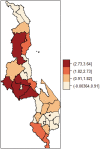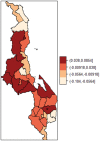Spatial disparities in impoverishing effects of out-of-pocket health payments in Malawi
- PMID: 35322766
- PMCID: PMC8956308
- DOI: 10.1080/16549716.2022.2047465
Spatial disparities in impoverishing effects of out-of-pocket health payments in Malawi
Abstract
Background: Out-of-pocket health payments as a means of financing health services are a cause of concern among households in low and middle-income countries. They prevent households from accessing health care services, can disrupt households' living standards by reducing consumption of other basic needs and push households into poverty. Previous studies have reported geographical variations in impoverishing effects of out-of-pocket health payments. Yet, we know relatively little about spatial effects on impoverishing effects of health payments.
Objective: This paper assesses the factors associated with impoverishing effects of health payments and quantifies the role of districts spatial effects on impoverishment in Malawi.
Methods: The paper uses a cross sectional integrated household survey data collected from April 2016 to April 2017 among 12447 households in Malawi. Impoverishing effect of out-of-pocket health payments was calculated as the difference between poverty head count ratio before and after subtracting health payments from total household consumption expenditures. We assessed the factors associated with impoverishment and quantified the role of spatial effects using a spatial multilevel model.
Results: About 1.6% and 1.2% of the Malawian population were pushed below the national and international poverty line of US$1.90 respectively due health payments. We found significant spatial variations in impoverishment across districts with higher spatial residual effects clustering in central region districts. Higher socio-economic status (AOR=0.34, 95% CI=0.22-0.52) decreased the risk of impoverishment whereas hospitalizations (AOR=3.63, 95% CI 2.54-5.15), chronic illness (AOR=1.56, 95% CI=1.10-1.22), residency in rural area (AOR=2.03, 95% CI=1.07-4.26) increased the risk of impoverishment.
Conclusions: Our study suggests the need to plan financial protection programs according to district specific needs and target the poor, residents of rural areas and those with chronic illnesses. Policy makers need to pay attention to the importance of spatial and neighborhood effects when designing financial protection programs and policies.
Keywords: Malawi; Out-of-pocket health payments; financial protection; spatial multilevel model; universal health coverage.
Conflict of interest statement
No potential conflict of interest was reported by the author(s).
Figures
Similar articles
-
Examining the incidence of catastrophic health expenditures and its determinants using multilevel logistic regression in Malawi.PLoS One. 2021 Mar 31;16(3):e0248752. doi: 10.1371/journal.pone.0248752. eCollection 2021. PLoS One. 2021. PMID: 33788900 Free PMC article.
-
What has been the progress in addressing financial risk in Uganda? Analysis of catastrophe and impoverishment due to health payments.BMC Health Serv Res. 2020 Aug 12;20(1):741. doi: 10.1186/s12913-020-05500-2. BMC Health Serv Res. 2020. PMID: 32787844 Free PMC article.
-
Assessing the impoverishing effects, and factors associated with the incidence of catastrophic health care payments in Kenya.Int J Equity Health. 2017 Feb 6;16(1):31. doi: 10.1186/s12939-017-0526-x. Int J Equity Health. 2017. PMID: 28166779 Free PMC article.
-
Economic Burden of Chronic Ill Health and Injuries for Households in Low- and Middle-Income Countries.In: Jamison DT, Gelband H, Horton S, Jha P, Laxminarayan R, Mock CN, Nugent R, editors. Disease Control Priorities: Improving Health and Reducing Poverty. 3rd edition. Washington (DC): The International Bank for Reconstruction and Development / The World Bank; 2017 Nov 27. Chapter 6. In: Jamison DT, Gelband H, Horton S, Jha P, Laxminarayan R, Mock CN, Nugent R, editors. Disease Control Priorities: Improving Health and Reducing Poverty. 3rd edition. Washington (DC): The International Bank for Reconstruction and Development / The World Bank; 2017 Nov 27. Chapter 6. PMID: 30212160 Free Books & Documents. Review.
-
Co-payments for general practitioners in Denmark: an analysis using two policy models.BMC Health Serv Res. 2017 Jan 5;17(1):9. doi: 10.1186/s12913-016-1951-z. BMC Health Serv Res. 2017. PMID: 28056968 Free PMC article. Review.
Cited by
-
Household costs and care seeking patterns associated with COVID-19 in Blantyre, Malawi.PLOS Glob Public Health. 2023 Jun 26;3(6):e0002003. doi: 10.1371/journal.pgph.0002003. eCollection 2023. PLOS Glob Public Health. 2023. PMID: 37363908 Free PMC article.
-
Spatial distribution and characteristics of women reporting cervical cancer screening in Malawi: An analysis of the 2020 to 2021 Malawi Population-based HIV Impact Assessment survey data.PLoS One. 2024 Oct 10;19(10):e0309053. doi: 10.1371/journal.pone.0309053. eCollection 2024. PLoS One. 2024. PMID: 39388421 Free PMC article.
References
-
- World Health Organization (WHO) . The world health report: health systems financing. Geneva: World Health Organization; 2010.
-
- Xu K, Evans DB, Kawabata K, et al. Household catastrophic health expenditures: a multi-country analysis. Lancet. 2003;362:565–12. - PubMed
-
- Wagstaff A, Van Doorslaer E.. Catastrophe and impoverishment in paying for health care: with applications to Vietnam 1993–1998. Health Econ. 2003;934:921–934. - PubMed
-
- World Health Organization and International Bank for Reconstruction and Development/The World Bank . Global monitoring report on financial protection in health 2019. Geneva; 2020. Licence: CC BY-NC-SA 3.0 IGO, editor.
-
- Wagstaff A, Flores G, Smitz M, et al. Progress on impoverishing health spending in 122 countries: a retrospective observational study. Lancet. 2018;6:5–10. - PubMed
Publication types
MeSH terms
Grants and funding
LinkOut - more resources
Full Text Sources
Miscellaneous


